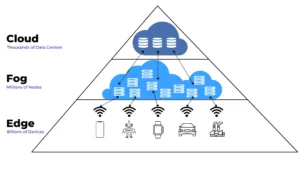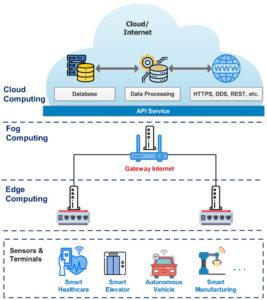Understanding Fog Computing, Grid Computing, and Cloud Computing: A Comprehensive Guide
In today’s tech-driven world, various computing models are transforming the way businesses handle data and processes. Among the most significant are fog computing, grid computing, and cloud computing. Each of these models has distinct advantages, architectures, and use cases. This blog will break down the differences between these three types, starting from the basics to their advanced applications.

Fog Computing: Bringing Processing Closer to the Edge
Fog computing is a decentralized architecture where computing resources such as processing and storage are brought closer to the source of data, such as IoT devices or sensors. Unlike traditional cloud models, where data is sent to distant data centers for processing, fog computing processes data at local nodes (e.g., routers, gateways) closer to the data source.
Key Features:
– Low Latency: Since data is processed locally, fog computing offers extremely low latency, making it ideal for real-time applications.
– Improved Bandwidth Efficiency: By reducing the need to transfer large volumes of data to the cloud, fog computing optimizes bandwidth usage.
– Local Data Processing: Sensitive data can be processed locally, improving privacy and security.
Use Cases of Fog Computing:
– Autonomous Vehicles: Vehicles can process real-time data (e.g., from sensors) locally to make instant driving decisions.
– Smart Cities: Traffic control systems and surveillance cameras in smart cities can operate more efficiently by processing data close to the source.
– Industrial IoT: Factories utilizing IoT devices can use fog computing for real-time equipment monitoring and automation.
Challenges:
– Complex deployment and maintenance of decentralized devices.
– Limited scalability compared to cloud computing.
Grid Computing: Distributing Processing Power Across Systems
Grid computing is a distributed computing model where a network of loosely connected computers work together to solve large, complex tasks. Instead of relying on a single machine, grid computing distributes tasks across multiple systems, often utilizing idle processing power.
Key Features:
– Parallel Processing: Grid computing allows multiple computers to work on a task simultaneously, significantly speeding up large computations.
– Cost-Effective: Leveraging existing resources (such as underutilized computers) makes grid computing cost-effective.
– Geographically Distributed: Grid nodes can be located anywhere, and they contribute their processing power to the grid.
Use Cases of Grid Computing:
– Scientific Research: Complex tasks like climate modeling, DNA sequencing, and particle physics experiments (e.g., CERN’s Large Hadron Collider) rely on grid computing for massive data analysis.
– Data Mining: Businesses can use grid computing for mining large datasets to uncover patterns and trends.
– Financial Simulations: Banks and financial institutions can perform large-scale risk assessments and financial forecasting using grid computing.
Challenges:
– Network bottlenecks can occur when connecting multiple computers.
– Ensuring security and data privacy across a wide grid network can be difficult.
Cloud Computing: On-Demand Resources Over the Internet
Cloud computing is the most widely known and used model today, providing on-demand access to computing resources (storage, processing, networking) over the internet. Instead of managing physical servers or infrastructure, businesses can rent resources from cloud providers like AWS, Microsoft Azure, or Google Cloud.
Key Features:
– Scalability: Cloud computing offers virtually unlimited scalability. Businesses can scale up or down based on demand, making it highly flexible.
– Pay-As-You-Go: Cloud providers charge based on usage, making it cost-effective for businesses that don’t want to invest in infrastructure.
– High Availability: Cloud providers ensure high availability and redundancy, minimizing downtime for critical applications.
Use Cases of Cloud Computing:
– Web Applications: Cloud computing powers millions of websites, apps, and e-commerce platforms globally.
– Big Data Analytics: Organizations use cloud computing for data processing, machine learning, and AI tasks that require massive computational power.
– SaaS (Software as a Service): Companies can offer software solutions over the cloud, such as CRM, HR management, or accounting platforms.

Challenges:
– Data security and privacy concerns, especially in public clouds.
– High bandwidth usage due to constant data transfers between user systems and cloud servers.
Comparing Fog Computing, Grid Computing, and Cloud Computing
|
Factor |
Fog Computing |
Grid Computing |
Cloud Computing |
| Processing Location | Near the edge (close to devices) | Distributed across many nodes | Centralized in cloud data centers |
| Latency | Low | Moderate | High |
| Scalability | Local scalability | Highly scalable across connected computers | Extremely scalable (via cloud resources) |
| Cost | High upfront, lower ongoing bandwidth costs | Moderate, often cost-effective | Pay-as-you-go, can scale with usage |
| Security | Complex, but data can be processed locally | Varies, dependent on node security | Strong, centralized security measures |
Each computing model has its advantages based on specific needs:
– Fog Computing is best suited for real-time, low-latency applications like IoT and smart cities.
– Grid Computing is ideal for large-scale, distributed tasks such as scientific computations and data analysis.
– Cloud Computing offers scalability, cost-effectiveness, and flexibility for general-purpose tasks, SaaS platforms, and data-heavy applications.
For more Cybersecurity related content Follow: Cyber Point Solution, Youtube

